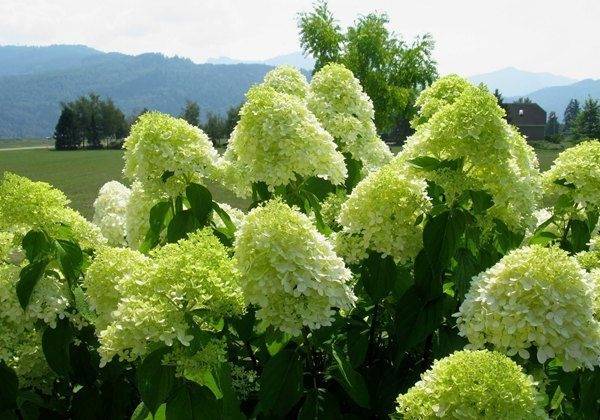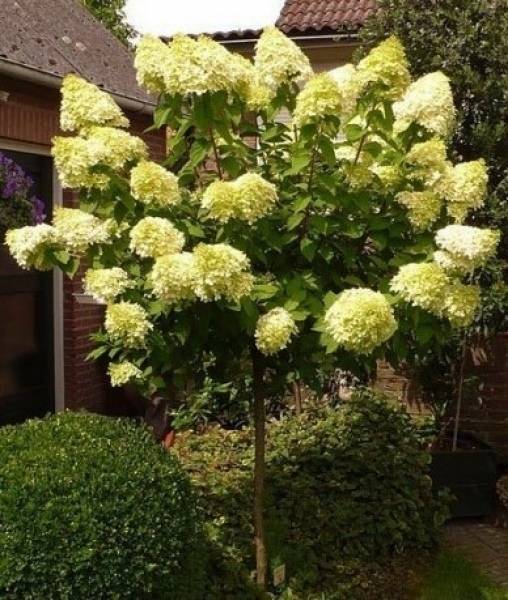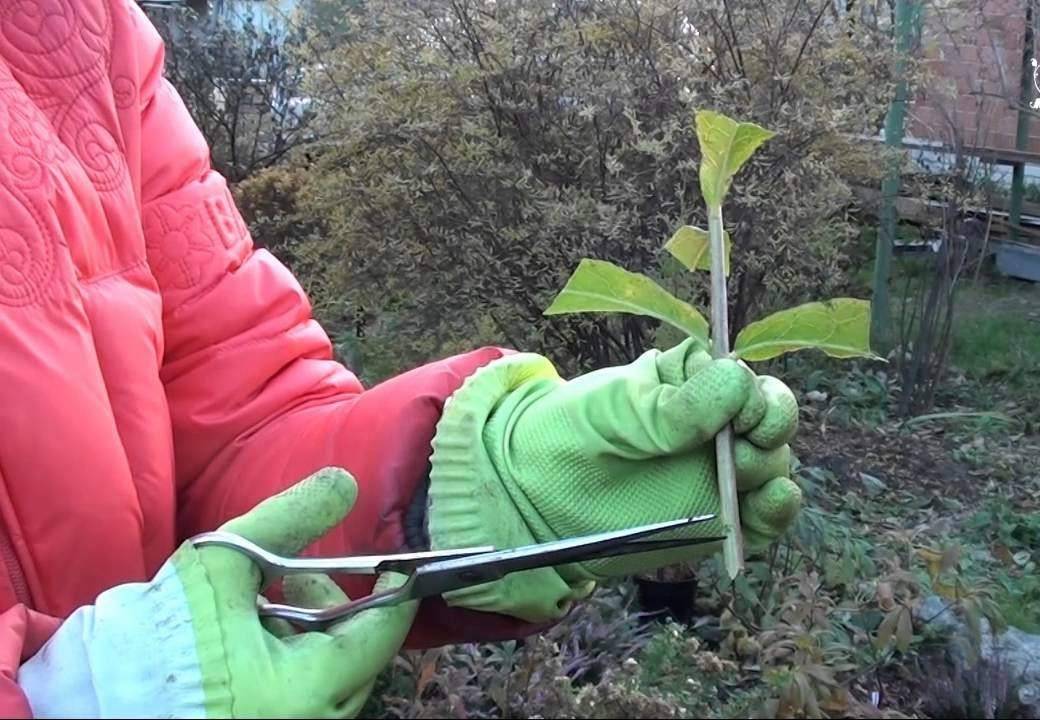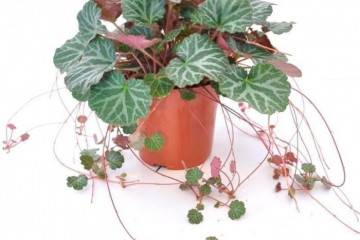Hydrangea Limelight - description of the flower and its appearance
Content:
Hydrangea paniculata, Limelight panicle hydrangea, or lemon hydrangea, is loved by many summer residents and gardeners for the lack of disadvantages that other varieties of panicle hydrangeas have. Immediately after the breeding, which by the way happened in Holland, Limelight hydrangea gained immense popularity and settled in the plots of many summer residents. This type of hydrangea in its name does not in vain refer to such a plant as lemon, because the bright yellow color of the flowers strongly resembles the greenish-lemon color.
Description of hydrangea Limelight
The main value of this variety lies in the presence of shoots in it, the strength and rigidity of which can easily keep on weight a huge number of inflorescences formed during the period of active flowering. It is this property that makes it possible for the Lime-light panicle hydrangea to maintain its decorative shape and extremely compact dimensions.
In terms of its biological appearance, a variety of panicle hydrangeas called Limelight, or, as it is also called, the Little Light hydrangea is a flowering deciduous shrub, the size of which can reach 2.5 m in height. Development and growth of hydrangeas are extremely active, the annual growth is the height can be up to 25 cm.
The branches of the shrub are straight and have good rigidity, due to which during flowering it is not required to tie up the plant, as well as provide it with any support. Lime hydrangea has dark brown shoots. The leaves are also dark green in color, slightly velvety and very pleasant to the touch. The green mass is quite dense, it is difficult to notice the shoots behind it. During the fall season, the leaves change their color, acquiring lilac tones. It is because of this feature that many people love Limelight so much.
How and where to plant
A plant such as the Limelight hydrangea should be planted in mid-May. Earlier dates should not be considered due to the fact that the spring weather is quite unstable and can throw up frosty "surprises" that the plant will not like. In later periods, the high ambient temperature will become an obstacle to the rapid and high-quality development of a young bush. If planting is done correctly, this beautiful plant will improve the landscape design of any site.
To plant a panicle hydrangea, you need to dig a planting hole. You should not go deep, 40-50 cm is enough, because in such a shrub, the root system is located on the surface. The diameter of the planting pit should be about 50-60 cm.
After digging a hole, it must be well moistened. This can be done by pouring a couple of buckets of clean water there. After about a day, after the final absorption of moisture into the ground, it is worth starting to plant a bush. To make the hydrangea feel great, you need to fill the hole a third with the following mixture, consisting of:
- ordinary land, the slide of which was formed after digging a hole;
- coniferous land;
- humus;
- peat;
- sand.
Further, after laying the earth mass, which amounted to a third of the height of the pit, it is necessary to install the seedling right in the center. After that, the bush is fixed with ordinary garden soil and compacted a little. When properly planted, the root neck of the plant should be level with the ground.
After successful planting of the plant on the site, it is necessary to thoroughly water it. This will require a bucket of water.
Despite the fact that this hydrangea variety is not too whimsical, it will not be able to show a good level of growth in every area. The land in which it is planned to plant Limelight hydrangea must be suitable and have the following indicators:
High-quality soil composition
A high-quality soil composition is characterized by an indicator of soil acidity. Hydrangea Lime, unlike many other varieties, will be able to root perfectly in soil that has sufficient acidity. To improve the quality of growth, it is worth adding peat to the ground.
Low illumination of the landing site
This variety of hydrangeas is very bad for direct sunlight. For planting, you should choose a site that is relatively weakly lit, and the sun's rays do not hit the leaves throughout the day.
Excellent humidity
Hydrangea paniculata Lime is a type of plant that needs a sufficient amount of moisture to grow. Poorly moistened soil will become destructive for it. However, when choosing a wet site for planting, you need to pay attention to the fact that there is no stagnation of liquid on it, otherwise this can lead to wilting of the plant.
Reproduction of the Limelight variety
Reproduction of this hydrangea variety is possible in only two ways.
Cuttings
Propagation of hydrangea Limelight by this method should be done in June, or rather, closer to the middle of the month. For the procedure of grafting and cutting branches, it is better to choose the shoots of this year. It is necessary to cut them into pieces, which will have three leaf pairs. The bottom of the pairs will need to be removed, and the cuttings themselves should be soaked for a while in a solution of a root growth stimulator.
The resulting shoots must be dug into separate pots, which are filled with a soil mixture consisting of ordinary leafy soil and peat in a 50:50 ratio. The seedlings will need to be covered with a glass jar and put back at room temperature. If it is within 20 ° C, then the rooting process will be completed in about one and a half to two months. After rooting, the seedlings grow in the container for several years and only then can they be moved to the open ground.
Dividing the bush
This breeding method is possible only if the hydrangea bush is planned to be transferred to a new site. The bush should be divided into several parts, the number of which should not exceed three. It is necessary that each one has several points of growth at once, as well as strong roots. After the end of the process of dividing the bush into parts, the processes can be immediately added dropwise.
Care for panicle hydrangea
It was already mentioned above that such a variety of panicle hydrangeas is quite unpretentious.Caring for the bushes will not take much time, however, in order to obtain the most beautiful bush and sufficient decorative effect, it will be necessary to carry out some procedures.
Sufficient and frequent watering
The bushes need to be provided with periodic watering, keeping the land on which it grows constantly moist. In demi-season periods, it is recommended to water the plant once every two to three weeks. In summer, when it's hot outside, water is often watered - once every few days.
Competent and timely feeding
Fertilize panicle hydrangea systematically. This will allow the bush to develop properly.
Trimming
This is a must-have event for growing a beautiful and long-lived hydrangea bush. Pruning happens:
- formative. The process of forming the appearance of the future bush should begin in the spring, until the buds bloom. Last year's shoots remaining on the bush should not be touched when pruning, because future buds are on them. The remaining branches are cut depending on the length: two-thirds the longest and one-third more modest in size. It is also worth removing the shoots located along the deciduous crown to reduce the density;
- sanitary. A standard procedure required to increase the longevity and lifespan of lemon hydrangea. It is held in the autumn, around the beginning of November. With sanitary pruning, care should be taken to remove absolutely all dry and diseased processes. The weakest branches are also pruned and consistently cleaned of old inflorescences;
- anti-aging. Pruning to clean up old bushes. It is necessary to cut off old branches, leaving 5-6 young shoots. They should also be shortened, leaving about five buds on them.
Preparing for winter
Limelight panicle hydrangea is a fairly frost-resistant plant that can withstand severe frosts. However, young plants can still freeze a little. That is why it is necessary to cover the bushes, the age of which does not exceed three years.
Before the hydrangea begins to shelter for the winter, the branches of the bush are bent closer to the ground, after which they are fixed in this position. After already in this position, it is recommended to cover the plant with fallen leaves and cover it with roofing material.
The information from this article will help everyone who wants to plant and grow in their summer cottage such a beautiful plant as the Limelight panicle hydrangea. The bushes of this variety can be successfully used in landscape design, both singly and as a group planting in a flower bed. By planting a lemon hydrangea on his land, the florist will acquire a valuable and beautiful plant that will delight the eye with its long and unusual flowering.




















